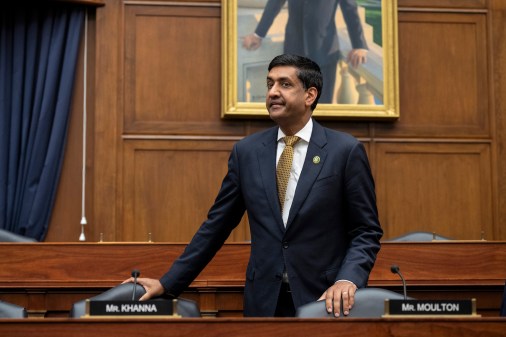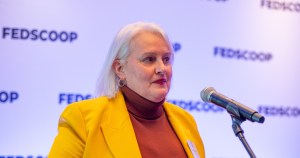- Sponsored
- Modernization
Improving customer experience with IT modernization and cloud adoption

Christian Hoff has more than two decades of leadership in business development, sales, and operations supporting federal civilian, military and intelligence community end users. Hoff serves as Director, U.S. Federal Civilian & Health Team at Amazon Web Services.
Citizens’ expectations of government are constantly changing. At the same time, they expect their interactions with the government to be predictable, simple to navigate, and comparable to their experience in the commercial marketplace. However, the tangled web of siloed federal government services remains a challenging constraint on customer experience.

Organizations that excel in customer experience distinguish themselves in part by the customer-centric leadership of their executives — and by having an engaged workforce committed to delivering responsive services.
In that regard, the Biden Administration’s recent Executive Order on “Transforming Federal Customer Experience and Service Delivery” represents an important milestone — and a significant departure from past government initiatives — in trying to meet end-user expectations.
The directive seeks to reshape Americans’ interactions with the government by holding flagship agencies “accountable for designing and delivering services with a focus on the experience of the people it is meant to serve” rather than merely streamlining the services themselves in individual silos.
It also presents federal leaders with an opportunity to rethink how they process and administer a wide range of federal services, from retirement payments, healthcare benefits, and food subsidies, to federal grants, education and housing loans, and taxes.
But to truly elevate the customer experience for American citizens, agencies will need to capitalize on a combination of technology and human-centered design.
Federal CIO Clare Martorana recently stressed that “technologists and customer-experience designers are working side-by-side with customer service and policy teams at agencies so that the public can quickly and efficiently access the services they need.” This is the type of teamwork that can lead to incredible impact.
Improving mission delivery with the cloud
IT modernization and cloud adoption have played critical roles in transforming public sector service delivery in recent years. Having helped many federal agencies in their journey to the cloud, we at AWS have seen three key areas for organizations to improve their CX — application modernization, real-time constituent response, and the development of enterprise data platforms. By leveraging the agility, speed-to-value, and ability to test and innovate in the cloud, agencies are discovering a cascade of benefits. A few examples include:
When the U.S. Census Bureau migrated their on-premises applications and associated databases to AWS, the bureau gained essential scalability and improved availability (achieving a 99.98% response rate using an online self-response tool). It also allowed IT leaders there to adapt and integrate new technologies more easily with practically zero capital expenditures.
Similarly, the Centers for Medicare and Medicaid Services has been able to deliver a stable and highly scalable set of features on Healthcare.gov, the portal where consumers can find information and sign up for insurance plans under the Affordable Care Act. By using AWS, CMS achieved the ability to handle hundreds of thousands of simultaneous users during peak insurance signup periods.
The U.S. National Archives and Records Administration (NARA), in another example, used the scalability of the Amazon Textract, a machine learning platform, to extract and ingest approximately 130 million handwritten names from the 1950 Census population schedules. That effort made it possible for NARA to make the entire 1950 Census searchable by website visitors when it was released this past April.
By teaming up with AWS, the U.S. Department of Education is leveraging open hybrid cloud technologies to modernize its G5 grants management system. The initiative will modernize the department’s operations, reduce complexity, promote equal access to grants for all students, and improve overall customer service.
Rapid response
Some of the most impressive examples of agencies moving faster than ever to upgrade citizen services were highlighted at AWS’s public sector summit in May.
During the event, U.S. Postal Service CIO Pritha Mehra shared how her organization designed and implemented a system in just three weeks, on AWS platforms, to handle millions of COVID test kit orders per hour. This public health initiative is part of the White House’s pandemic response. At its peak, during the first two weeks after launching, the usps.com/covidtests website accepted 8.7 million orders per hour, and more than 60 million households placed orders for their free test kits. To date, USPS has received 108 million orders for free COVID test kits and is now shipping 8 tests per order.
Similarly, IT leaders at the U.S. Customs and Border Protection (CBP) had just two weeks to develop and implement a solution when the contractor responsible for supporting three CBP call centers suddenly filed for bankruptcy. The requirements were daunting. CBP needed hardware, software, multiple language support, workflow automation, monitoring systems, zero downtime tolerances, and a host of specialized call center services — and train 300 employees on how to use the new system. As CBP Chief Cloud Architect Kyle Barnett described it, CBP was able to migrate three call centers in just 10 days, reduce operational and labor costs in the process, and improve integration, efficiency, resiliency, and response times.
Keep the innovation moving forward
Agencies have an added incentive right now to invest in high-impact customer experience improvement projects, thanks to a new $100 million Technology Modernization Fund announced by OMB and GSA on June 16. Projects that span agencies; reduce wait times, paperwork and bureaucratic barriers; and improve essential capabilities and systems will be prioritized by the TMF Board.
Investments in customer experience are not a one-time initiative, however. To deliver successfully, it involves an entire shift in mindset that must happen at every level of an organization. Agency leaders should be thinking about how to give employees the right tools, resources and policies to continue to provide exceptional service. When taking on efforts to marry customer experience with technology, it’s imperative to ensure employees are a part of the transformation process, minimizing any disparities in their digitization progress.
Modernizing the “behind-the-scenes”, IT functions at government entities is also crucial to transformation and customer experience. Leaders need to ensure they’re taking advantage of readily available tools, like the cloud, that can gather, automate, and analyze all data related to the entire customer experience in a way that is secure and compliant.
By working with partners like AWS, government agencies can deliver solutions that drive efficiencies, reduce costs and ultimately meet their mission of providing digital services for the country’s well-being.
Learn how AWS can help your agency improve communities and deliver new and improved services to Americans – contact AWS.




